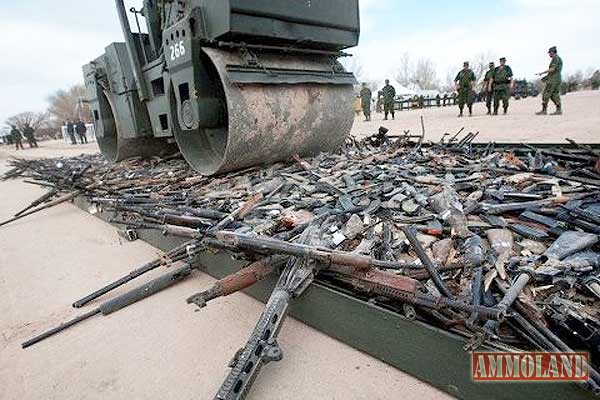Editors Note: The following is an alert sent on February 5th 2015 by TSM Worldwide.
UN Seeking Input on Draft International Standard on Civil Access to Small Arms


New York, NY – February 5th 2015 -(Ammoland.com)- As some of you may already know, TSM has been monitoring the situation with respect to the UN Arms Trade Treaty (ATT) and the UN International Small Arms Control Standards (ISACS) from Geneva for several years.
We thought you might find it interesting know that the UN ISACS multi-stakeholder initiative (MSI) recently reopened a comment period for a planned international standard on the “National Regulation Of Civilian Access to Small Arms and Light Weapons.” ( 19 February 2015 deadline for comments )
TSM was recently alerted to this situation. Before providing some details below, you should know the process of reviewing this particular international standard was started years ago, and was halted on December 8, 2011. According to an email by Dr. Patrick Mc Carthy, the ISACS MSI Coordinator, the reason for this stoppage was “significant opposition” and objections about the module being perceived as an “inflexible, one-size-fits-all approach; an overly bureaucratic approach that will not bring benefits relative to its cost of implementation, definitional problems, etc.”
1. The Documents. The proposed standard is attached for your review. Also attached is the previous version from several years ago. You may find it interesting to note that, among other things, the previous version makes no mention of the ATT. The new version now cites the ATT in the Forward, which implicitly communicates that the proposed standard is intended to serve as a normative complement to the ATT.
In international law, something that is “normative” is something that is designed to steer behavior and/or determine, reduce, or other wise constrain the freedoms and/or unilaterally shape the legal or factual situation of actors, be they state or non-state actors (e.g. corporations, individual natural persons).
This legal talk aside, the previous version of the draft was written by a Dr. Ed Laurance, a strategic advisor to IANSA ( http://iansa.org/ ), an organization known for its anti-gun advocacy. Its former leader, [Australian gun banner] Ms. Rebecca Peters, is on record stating she and IANSA “want a drastic reduction of gun ownership across the world,” and that rifles capable of being lethal at 100 meters, pump-action shotguns, semi-automatic rifles and shotguns, and handguns “have no legitimate use in civilian hands.” [See a video of Ms. Peters debating NRA’s Wayne LaPierre here].
As a final thought on the documents, it should be noted that the old document mentions self-defense as a legitimate purpose for civilians owning firearms. The new document does not.
2. Geneva Views. International arms control and legal specialists in Geneva appear to be in consensus that the ATT theoretically can create an implicit obligation for states to incorporate ISACS into national regulatory rules and/or formal national legislation. It all depends on how a state wants to interpret the vague language of the treaty, specifically its clever references to other normative instruments outside the treaty itself.
3. Feedback Process. Officially, the ISACS MSI comment process is open only to pre-screened and vetted group of experts of chosen or appointed by the UN ISACS MSI Project Board. The feedback method uses a portal hosted by Base Camp (https://un-casa-isacs.basecamphq.com/login). Right now, TSM estimates the expert group is approximately 90% composed of a coalition of like-minded [anti-gun] UN officials, state representatives, scholars, researchers and advocates from mostly European organizations such as the Small Arms Survey, Oxfam International, IANSA, SIPRI, Control Arms, and the like.
4. US Official Involvement. It should also be noted that the US Department of Justice has one official engaged in the ISACS MSI, from the BATF. This official has apparently remained an unadvertised observer to the process for years, and the reasons for this are not entirely clear. What is known is that the US Government is not listed as among the participants of the ISACS MSI, yet the BATF official’s name shows up on the distribution list of emails sent from un-casa-isacs.basecamphq.com. This lists also includes the aforementioned, Ms. Rebecca Peters.
a. While there are very good reasons for the US to be involved as an observer on the down-low, this does present problems ensuring the content of any draft ISACS is balanced and responsive to American national interests. Feedback by states is not prohibited at all, and singular officials from smaller countries like Iraq, have been quite active in the past providing feedback.
This said, the apparent policy of official silence by the US with respect to ISACS development, taken in the context of an international standards development MSI, effectively translates into American consent.
The rule of thumb in these settings: no sustained opposition or objection = agreement or consent.
b. Given the special context, silence by the US representative may even suggest a willingness on the part of the US Government to eventually incorporate proposed ISACS into national regulation. And this obviously could have adverse normative implications for the 60% of Americans who believe having a gun in the home makes them safer.
The silence of the BATF on the ISACS Drafts to date is a concern to many in the industry and outside it, but especially to gun owners and sportsman.
Having said this, it should be known that industry insiders don’t tend to make critical views known about their regulators. Such tends to be frowned upon as an opportunity-limiting move. This of course isn’t to say the BATF representative involved with the ISACS MSI would ever take retribution for such concerned industry feedback. By all accounts, the BATF representative is well regarded by industry, and he has been personally helpful to representatives of TSM as well. This said, TSM would not have written this paragraph had it been subject to regulatory oversight by the BATF.
5. Stakeholders Represented. The interests, goals, and concerns of industry, the shooting sports community, and civil arms rights and gun owners groups are represented by a very small minority on the ISACS MSI.
Perhaps there are 7 people, with maybe two or three actually being Americans. This has been the case since the outset of the ISACS MSI, well over 5 years ago. Moreover, no American pro-gun civil society group has been a party to this process.
TSM does not know if this was out of a lack of interest or awareness or if such groups were denied outright the opportunity to participate.
Whatever the truth is, the only pro-gun organization actively contributing with well considered feedback citing academic studies and actual policy practice has been the Canadian National Firearms Association, represented specifically by Dr. Gary Mauser (Professor Emeritus of Simon Fraser University). Unfortunately, Dr. Mauser has previously reported to TSM that all his feedback has been systematically ignored because the ISACS MSI sponsors, and the ISACS Coordinator in particular, have “ignored everything they didn’t want to hear.” This dismissive and disregarding approach to minority views on the part of a UN sponsored international standard setting undertaking has been substantiated by representatives of the Defense Small Arms Advisory Council, the British Sports Shooting Council, the World Forum of Shooting Sports Activities, and the Sporting Arms and Ammunition Manufacturers Institute (SAAMI).
6. Credibility Problems and Indicators of Misconduct by UN officials. SAAMI, an ISO-accredited standard setting body itself, declared its formal opposition to the ISACS MSI in 2012, after presenting a minority report detailing major breaches in standard setting protocol, bias, etc. This raised serious concerns about the credibility of the ISACS MSI to many. The report, when read carefully with an awareness to UN employment rules, paints a picture of the ISACS MSI as something approaching an organized enterprise of professional misconduct on the part of certain UN officials.
TSM has done some inquiry in this direction and has found that there is a reasonable basis to conclude some key individuals at the UN engaged in conduct variously prohibited in the UN Charter (Articles 100, 101), the UN Oath of Office, the Standards of Conduct for International Civil Servants, and the UN Staff Rules and Regulations.
Specifically, what seems to be of material concern to interested parties is the appearance on its face that the ISACS Coordinator (Dr. Patrick Mc Carthy), along with ISACS MSI Board Members, have abused their positions as international public authorities to effectively “prejudice the positions of those they do not favor,” in a manner that is both widespread and systematic (i.e. such behavior reportedly happened frequently, in many different standard setting process contexts, and appears to be part of an standard operating procedure implied by project documents in the possession of TSM). Such indicated discrimination and abuse of international public authority are specifically prohibited in UN Staff Regulation 1.2 paragraph g. and a.
7. Non-Conformance with UN Principles of Effective Governance. The SAAMI minority report described issues with respect to the ISACS MSI’s non-conformance to accepted principles of international standards development. TSM has come to the conclusion that the ISACS MSI appears to also be in non-conformance with accepted UN principles of effective MSI governance. These MSI principles, first published in 2007, imply, among other things, the ISACS MSI should have provided genuine equal access to decision-making structures, shared control of agenda setting, and taken active measures to offset obvious power imbalances between the majority of stakeholders aligned with the sponsors of the ISACS MSI and the minority of stakeholders aligned with the interests, goals, and concerns of industry.
8. Informal Feedback Channel. To ensure the ISACS standard reflects “global expert opinion” pursuant to the second principle of ISO international standards development, TSM encourages interested parties with relevant legal and policy matter expertise to read the proposed Standard and send polite and considered commentary directly to Dr. Patrick Mc Carthy. TSM requests such parties make their informal feedback public, by posting them online [AmmoLand Shooting Sports News Publishes Letters to the Editor Online], and by sending a copy to TSM ( info(at)tsmworldwide.com ), which will retain the feedback for submission as part of a larger report being prepared for representatives of the US Government, the UN ISACS MSI, and the UN Secretary General. Dr. Mc Carthy’s contact information is below:
Dr. Patrick Mc Carthy
International Small Arms Control Standards (ISACS) Inter-Agency Support Unit
United Nations, 405 E. 42nd St., Office S-3145, New York, NY 10017, USA
+1 (917) 367-4689 | patrick.mccarthy@smallarmsstandards.org | www.smallarmsstandards.org
ISACS03.30(CiviliaDraft International Small Arms Control Standard, ISACS 03.30, Draft 3.1ns)3.1
Decisions made or actions taken on the basis of this Event Alert are solely the responsibility of any such decision makers or actors. Views expressed in this Alert are not necessarily the views of TSM Worldwide LLC, it partners, or its affiliates. This Alert maybe freely distributed. Partial or complete republication online or in print is authorized when TSM Worldwide LLC is cited as the source. See other published international legal items here. © All Rights Reserved. TSM Worldwide LLC. www.tsmworldwide.com
